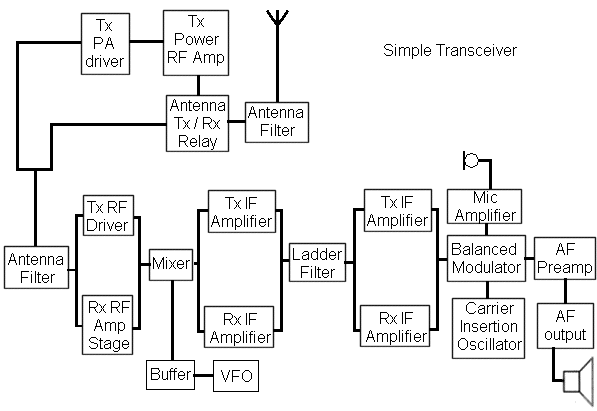|
| |||||||||||||
|
Bredhurst Receiving and Transmitting Society |
| ||||||||||||
|
| |||||||||||||
|
Syllabus Sections:- Transceivers 4r.1 Understand that transceivers normally share oscillators between the transmitter and receiver circuits; and may use common i.f. filters to limit both the transmitter and receiver bandwidths. They also use common change-over circuits.
In a transceiver the local oscillator can also be the transmitter VFO. The IF amplifier and filter used on RX and is used on Tx to generate SSB signals and thereby limit the bandwidths. The BFO on receive can be the CIO on Transmit The antenna will need some form of change over relay from Rx to Tx. Some tuned circuit can be used on Rx and Tx in the low power stage. In the early days some used a 9MHz IF and a VFO that went from 5MHz to 5.5MHz. This gives from the mixer frequencies that you can have 14MHz to 14.5MHz and 3.5MHz to 4MHz. So one filer can be use on Rx and Tx and one VFO on Rx and Tx. This was earliest and most often used relationship in a simple transceiver. To go on other band 7MHz and 21MHz you would need to mix the 5 - 5.5MHz with crystal which then become a crystal mixer VFO to then mix with the 9MHz to give you the other RF frequencies.
This block diagram is based upon the the BITX SSB transceiver see links page. Recall the function and use of the RIT control The RIT control allows you to change the receive frequency whilst leaving the transmitter on the original frequency. The way to use this is when the station with whom you are in QSO moves his TX frequency you adjust your RIT which changes the receive frequency. When you then next transmit you will still TX on the original frequency and with any luck the other station will bring his equipment back on frequency. If you did not do this you would end up chasing each other up or dawn the band.
| |||||||||||||
|
| |||||||||||||
|
| |||||||||||||
|
| |||||||||||||











